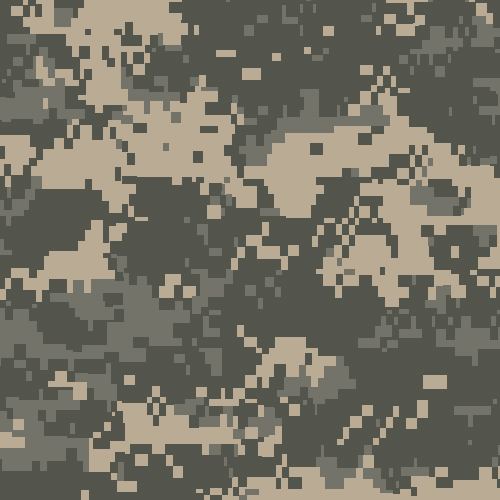 | ||
The Universal Camouflage Pattern (UCP), also referred to as ACUPAT (Army Combat Uniform Pattern) or Digital Camouflage (digicam), is the military camouflage pattern used in the United States Army's Army Combat Uniform. The pattern was chosen after several laboratory and field tests that occurred from 2003 to 2004, although it has been established that UCP may well have been adopted without field testing against other patterns. Its pixelated pattern is a modification of the United States Marine Corps' MARPAT camouflage pattern which is similar to the Canadian CADPAT scheme.
Contents
- Initial patterns and colors
- Test sites
- Elimination of patterns
- Phase II III
- Phase IV system level
- Results
- Color selection
- Controversy
- Cancellation and replacement
- References
The effectiveness of the pattern was questioned, leading to several research programs being conducted to modify or replace the current standard issue pattern. In July 2014, the Army announced that Scorpion W2 had been selected as the replacement pattern, and will completely replace the former pattern by the end of September 2019.
Initial patterns and colors
Three patterns were developed, called All Over Brush, Track, and Shadow/Line. For each pattern, there were four color combinations, which corresponded to a specific type of terrain, however, all four patterns used tan as their base color. The three remaining colors were green, brown, and black for the Woodland pattern, dark tan, khaki, and brown for the Desert pattern, light gray, medium gray, and black for the Urban pattern, and dark tan, light gray, and brown for the Desert/Urban pattern.
Test sites
There were fifteen evaluations, which took place at Fort Benning, Fort Polk, Fort Irwin, Fort Lewis, and Yakima, Washington. The camouflage patterns were then rated on their blending, brightness, contrast, and detection by U.S. Army soldiers, during the daytime, and also at night using night vision devices.
Elimination of patterns
Following testing, the Shadow Line pattern was eliminated entirely, along with the urban and desert/urban patterns of All Over Brush. All four of the Track patterns were accepted along with All Over Brush's woodland and desert patterns.
Phase II & III
The patterns were then modified and tested alongside a newly introduced "Contractor-Developed Mod" pattern, MultiCam. Near Infrared testing determined that black, medium gray, and medium tan were the only colors that gave acceptable performance.
Phase IV (system level)
All four remaining patterns, desert Brush, MultiCam, Woodland Track, and Urban Track were then tested alongside each other in urban, woodland, and desert environments.
Results
The desert Brush design received the best overall mean daytime visual rating. Contractor developed pattern received highest rating in woodland environments, but low ratings in desert and urban environments. Urban Track was generally the 3rd or 4th worst performer at each site, but was the best performer in nighttime environments. Infrared testing showed negligible differences in the performance of the four patterns. Natick rated the patterns from best to worst as: Desert Brush, Woodland Track Mod, Contractor-Developed Mod, and Urban Track.
Color selection
The color scheme of the Army Combat Uniform is composed of tan (officially named Desert Sand 500), gray (Urban Gray 501), and sage green (Foliage Green 502). The pattern is notable for its elimination of the color black. Justification given for the omission of black was that black is a color not commonly found in nature. Pure black, when viewed through night vision goggles, can appear excessively dark and create an undesirable high-contrast image. This argument was not accepted by the Canadian forces or the Marine Corps when they adopted the preceding CADPAT and MARPAT patterns respectively.
Controversy
The U.S. Army reported to the media that the basis for the UCP was the Urban Track pattern, which had been modified through the removal of black from the pattern and pixelated. Why the Urban Track pattern was used, given that it received the poorest ratings in visual detection from the Natick Soldier Center's testing, was unexplained. This also means that the new UCP pattern never underwent proper field testing.
Some soldiers have reported that the pattern is less than ideal in most environments, particularly jungle and tropical terrain. As the U.S. Army is involved in the Middle East, the uniform may have been biased towards the current operating environments.
When passed by the Senate, House of Representatives Bill 2346 required the Department of Defense to "take immediate action to provide combat uniforms to personnel deployed to Afghanistan with a camouflage pattern that is suited to the environment of Afghanistan." The Army is evaluating alternative camouflage patterns to determine if this was a necessary action. In recent tests conducted by the U.S. Army's Natick Soldier Center, results indicated that three other patterns did significantly better than UCP in desert and woodland environments. Four commercial submissions were tested to replace UCP for Army use.
Cancellation and replacement
In 2014, the United States Army cancelled the Universal Camouflage Pattern, and Army researchers worked on a new and better camouflage. Four new patterns were tested to give soldiers different patterns suitable for different environments, plus a single neutral pattern, to be used on more expensive body armor and other gear. The selection involved hundreds of computer trials as well as on-the-ground testing at half a dozen locations around the world. In May 2014, the Army announced that a pattern called Scorpion, a pattern similar to MultiCam that was developed for the Objective Force Warrior program in 2002 and modified in 2009 (W2 version), had been chosen as the replacement for UCP. On 31 July 2014, the Army formally announced that the Scorpion W2 pattern, officially named the Operational Camouflage Pattern, will begin being issued in uniforms in summer 2015. The name Operational Camouflage Pattern is to emphasize its use beyond Afghanistan to all combatant commands, with a family of versions, including a dark jungle-woodland variant and a lighter pattern for deserts. The Universal Camouflage Pattern will officially be retired by the Army by the end of September 2019.
